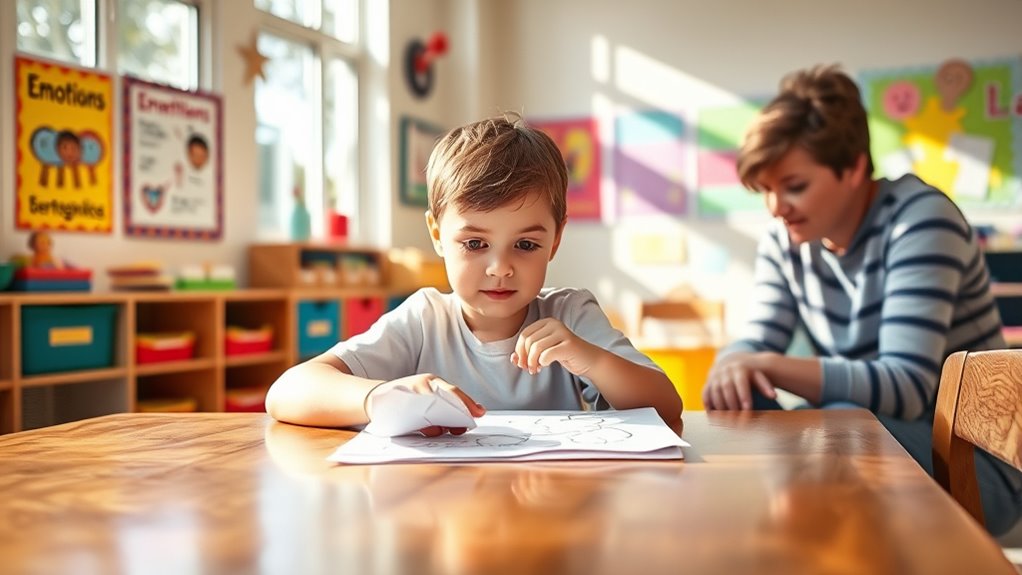To help your children build resilience and cope with frustration, encourage emotional awareness by naming feelings and creating a safe space to express emotions. Model calm reactions and teach self-regulation techniques like deep breathing or taking a break. Praise their efforts and remind them setbacks are temporary. In doing so, you foster patience, confidence, and problem-solving skills that will serve them long-term. Keep exploring ways to support their emotional growth to set a strong foundation for resilience.
Key Takeaways
- Model calm emotional responses and verbalize feelings to teach children constructive ways to handle frustration.
- Encourage children to identify and express their emotions in a safe, supportive environment.
- Teach self-regulation techniques like deep breathing, counting, or stepping away to manage frustration effectively.
- Reinforce that setbacks are temporary, fostering patience, resilience, and a growth mindset.
- Praise efforts to cope with frustration, boosting confidence and problem-solving skills for future challenges.

When children face setbacks or challenges, their ability to handle frustration can shape their future resilience. At this critical moment, nurturing their emotional intelligence becomes essential. Emotional intelligence helps children recognize and understand their feelings, making it easier for them to manage frustration instead of reacting impulsively. As you guide your child through frustrating situations, you’re helping them develop patience—an important skill that allows them to stay calm and composed. Patience development is a gradual process, but with consistent effort, your child learns that setbacks are temporary and manageable, fostering a mindset that values persistence over giving up.
You can start by modeling emotional intelligence yourself. When you’re upset or frustrated, verbalize your feelings in a calm way, showing your child how to process emotions constructively. For example, saying, “I’m feeling frustrated because this task is difficult, but I will take a deep breath and try again,” demonstrates patience and self-control. When your child witnesses this behavior, they learn that emotions are natural but manageable. Encourage them to identify their feelings by asking questions like, “Are you feeling angry, sad, or disappointed?” This helps them build awareness, which is a cornerstone of emotional intelligence.
Creating a safe space for your child to express frustration is equally important. Let them know that it’s okay to feel upset and that emotions are valid. When they express their feelings, listen actively without immediately trying to fix the problem. This validates their experience and teaches them to acknowledge their emotions, a step toward developing patience and emotional resilience. As they practice self-regulation, they begin to understand that frustration is a temporary state that can be overcome with patience and effort. Developing emotional intelligence can also improve their ability to seek help when needed, fostering independence and problem-solving skills.
Introduce simple coping strategies, such as taking deep breaths, counting to ten, or stepping away briefly from a challenging task. These techniques cultivate patience and emotional regulation. Praise their efforts when they manage frustration well, reinforcing positive behavior. Over time, they learn that frustration isn’t a signal to give up but an opportunity to practice patience and problem-solving skills. Building resilience through emotional intelligence and patience development equips your child to face future challenges with confidence, resilience, and a healthy attitude toward setbacks. By fostering these skills early, you’re giving them tools that will serve them throughout their lives.
Frequently Asked Questions
How Can Parents Model Resilience Effectively at Home?
You can model resilience at home by demonstrating patience when challenges arise and showing empathy toward your child’s feelings. When you face setbacks, talk openly about your process of coping and staying calm, so your child learns how to handle frustration. By practicing patience yourself and empathizing with their struggles, you teach your child valuable skills for resilience, helping them develop a positive mindset and emotional strength over time.
What Are Common Signs Children Struggle With Frustration?
You’ll notice children struggling with frustration show emotional awareness challenges, like difficulty identifying or expressing feelings. They might become easily irritable, withdraw, or have tantrums. Patience-building is key; if you see these signs, help them recognize emotions calmly and practice coping strategies. Over time, this supports their emotional awareness and resilience, making it easier for them to manage frustration healthily and build stronger emotional skills.
How Do Cultural Differences Influence Resilience Strategies?
Like Odysseus steering treacherous waters, you’ll find that cultural norms shape resilience strategies. In some cultures, resilience emphasizes collective strength and perseverance, while others focus on individual coping mechanisms. Recognizing these differences helps you support children better, respecting their backgrounds and fostering adaptive skills suited to their cultural contexts. Embracing diverse approaches enables children to develop resilience in ways that resonate deeply with their identities.
When Should Parents Seek Professional Help for Frustration Issues?
You should seek professional help when you notice signs of emotional distress, like persistent sadness, withdrawal, or extreme frustration in your child. If your parental guidance techniques don’t seem to improve their coping skills or if their frustration leads to aggressive behavior, consulting a mental health professional can provide valuable support. Early intervention helps your child develop healthier ways to manage emotions and build resilience effectively.
How Does Sibling Rivalry Impact a Child’s Resilience Development?
Think of sibling rivalry as a storm that tests your child’s resilience. Sibling dynamics often shape how children learn to handle setbacks, with rivalry impacts sometimes causing emotional strain. When siblings compete or compare, it can erode self-esteem and resilience. However, maneuvering these conflicts also offers opportunities for your child to develop coping skills, patience, and empathy—building resilience through real-life challenges.
Conclusion
As you guide your child through frustration, imagine planting a sturdy tree that bends with the wind but never breaks. Each challenge they face becomes a branch that strengthens their resilience, turning storms into growth. With your support, they’ll learn to weather life’s tempests, standing tall and confident. Remember, your patience and encouragement are the roots that hold their confidence steady, helping them blossom into resilient individuals ready to face whatever comes next.








